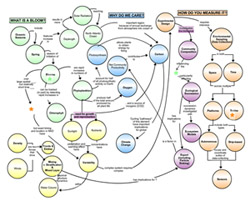| |  | | An overview of the NAB webinar series. Click for an interactive version of this map! |
This dynamic webinar series features the research of scientists from the North Atlantic Bloom (NAB) Experiment and focuses on key concepts in ocean science. The five-part series consists of presentations from NAB scientists, and tells the story of the North Atlantic spring phytoplankton bloom and its role in the ocean ecosystem. It describes the multi-faceted nature of this complex experiment and provides participants with a rich body of educational resources, including linked concept maps aligned to National Science Education Standards and access to datasets that have been translated into classroom activities.
Because of the complex nature and breadth of the experiment, this webinar series offers meaningful linkages to most, if not all, of the “cross-cutting scientific concepts” outlined in the New Framework of the National Science Education Standards. These concepts include “scale, proportion, and quantity,” “systems and system models,” “energy and matter: flows, cycles and conservation,” and “stability and change,” among others.
NAB Series: Archived Webinars
 |
Mary Jane Perry (Professor, School of Marine Sciences, University of Maine) gives an overview of the North Atlantic Bloom Project and describes the fundamentals of how phytoplankton bloom in the ocean. |
 | Amala Mahadevan and Melissa Omand (WHOI) explain how modeling has helped researchers to better comprehend the physical dynamics behind what triggers the spring bloom. |
 | Eric D’Asaro (Principal Oceanographer and Professor, APL-UW) presents his perspective on how it is possible to measure a moving, changing swatch of ocean at different scales, and the technology needed to collect meaningful data. |
 | Nicole Poulton (Bigelow Laboratory) and Ivona Cetinic (University of Maine) describing the ecological succession that happens during a phytoplankton bloom, and the consequences for the marine food web and for carbon exports. |
 | Craig Lee (Principal Oceanographer and Professor, APL-UW) wraps up the series with a “big picture” summary of what understanding the dynamics of the spring bloom will mean for scientists concerned about carbon and climate. |
|












